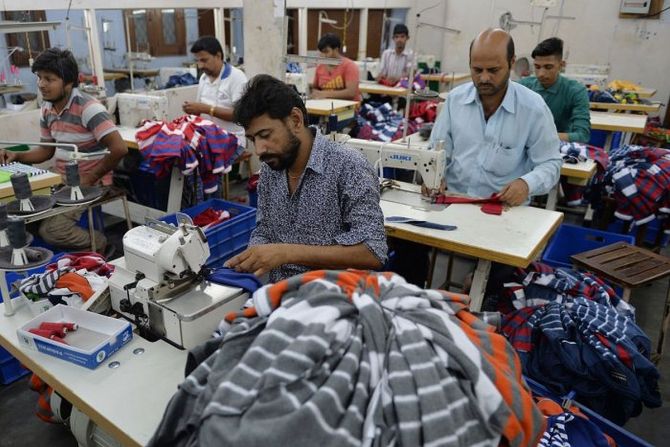 | « Back to article | Print this article |
Exporters say their capacity utilisation has reached almost 70 per cent and that big firms have brought it up to as high as 85 per cent.

After a washout in the first quarter, garment exporters in India are picking up the threads to effect an unexpected recovery by seizing an opportunity offered by souring Sino-US trade relations.
Exporters say their capacity utilisation has reached almost 70 per cent and that big firms have brought it up to as high as 85 per cent.
In many cases, the order book is up 10-12 per cent over pre-Covid-19 levels.
The demand recovery has been led by the US market, which accounts for 27 per cent of India’s garment exports.
According to a report by Wazir Advisors based on the US Census Bureau, between January and October apparel store sales in America were at $100 billion, around 33 per cent less than the same period last year.
But the dip was punctuated by sharp recovery of sales in June and September.
In April, monthly apparel sales were down by 88 per cent over April 2019, but recovered steadily month-on-month.
In September 2020, the drop was only 13 per cent over September 2019.
The increase in demand has led to spurt in imports, including from India that accounts for 4.6 per cent of US garment imports.
From January to September this year, the US imported apparel worth $47 billion, around 28 per cent less than the same period last year.
After reporting a 60 per cent drop in May 2020 over May 2019, the slump was only around 15 per cent in September.
Besides demand from existing customers, Indian suppliers have started getting new orders and enquiries that traditionally went to China.
For example, a recent Motilal Oswal report said that China’s market share (as a percentage of US imports) of terry towels and bedsheets fell by 350 basis points (to 21 per cent) and 510 basis points (to 15 per cent) between January and September.
In the same period, India’s market share in these two products jumped 360 and 90 basis points to 43 and 50 per cent, respectively.
This transition can be seen in Tiruppur, India’s export-oriented knitwear capital, where orders flows have jumped 15-20 per cent in the last three months.
Raja M Shanmugham, president, Tiruppur Exporters’ Association, attributes the surge to China.
“Our traditional markets — US and Europe — continue to be in the red, though they are improving month on month.
"We don’t have any other reason except the Chinese factor to attribute for this growth,” he said.
Tiruppur exports apparel worth around Rs 27,250 crore a year.
Textile firms confirm this development. During an investors’ call in September, the management of Raymond, the branded fabric and fashion retailer, said, “We have witnessed some of our large B2B customers indicating and evaluating shifts in the supply chain from China and we are becoming sort of a natural choice to them... We have identified about 18 partners around the world, and we are working closely with them...and we are hopeful that we will grab opportunities with a few of them.”
Sivaramakrishnan Ganapathi, managing director of Gokaldas Exports, the country’s leading apparel exporter, also confirmed that his company had this year bagged orders that used to go to China earlier.
However, old challenges remain. Countries such as Cambodia and Vietnam continue to leverage the raw material value chain in China and aim to expand their market share in the near term.
Exports from these countries are technically through Chinese companies, which have invested directly or indirectly as part of China Plus One (a strategy to cater to global markets by avoiding investments only in China), explained an official at a leading export house.
Vietnam and Bangladesh are late entrants compared to India and they do not have raw materials, which they import from China or India.
Despite these shortcomings, they are growing faster than India.
For instance, Bangladesh has raised garment exports from $26 billion to over $33 billion in the past five years, while India’s export has remained stagnant at $36 billion.
As the exporter noted, India is dependent on China for synthetics, certain kinds of fibres, yarns and fabrics because the capacity here is limited.
India imports nearly $460 million worth of synthetic yarn, $360 million worth of synthetic fabric (nylon) and around $140 million worth of accessories like buttons, zippers, hangers and needles, apart from machinery, a bulk of it from China.
However, the official is optimistic that India can grow and get a larger share of the pie, especially due to the circumstances.
For instance, the US government imposed sanctions on Xinjiang cotton — which accounts for 20 per cent of all the cotton in the world, nearly 80 per cent of China's cotton production and 50 per cent of the global spinning capacity.
The curbs are likely to benefit India, which is well-equipped with producing cotton-based garments, thanks to the availability of raw material for manufacturing all kinds of products.
But it’s in synthetics where major gains lie and where India lags.
The recent Production-Linked Incentive scheme of the Indian government is expected to accelerate growth as it provides incentives for manufacture and export of specific textile products made of man-made fibre.
But that capacity will take time to come on stream.
“It’s high time Indian industry and the government woke up to the fact that orders have started moving away from China and to India,” said Shanmugham, adding that the cost differential of around 10-15 per cent between the two nations is not a big constraint for overseas buyers.
The problem with Indian suppliers are quality and non-fulfilment of orders in time.
Shanmugham attributed these to lack of mass skilling.
Photograph: PTI Photo